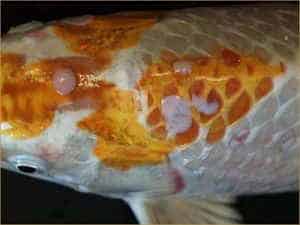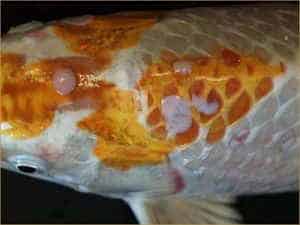A cousin of Koi Herpes Virus, Koi Pox, also known as Carp pox in koi, is also a herpes virus (Cyprinid herpesvirus-1). It is a fairly common disease for our office to see and this time of year, in colder water, you may be seeing more clinical signs than usual.
How do fish get Koi Pox?
Like any infectious disease, fish are great at sharing with their pondmates. And like herpes viruses in almost all other species, latent carriers can be present without ever showing any clinical signs. By the time you see clinical signs of Carp Pox on one fish, all of the other fish have already been infected. It is rare that most fish will show clinical signs of Carp Pox unless their immune system is not functioning well.
What are the signs of Koi Pox?
The traditional “candle wax” lesions are the way most owners can identify Carp Pox in their fish. However, additional signs such as a thickening of the epidermis on the fins is also commonly seen in our patients. This can commonly be confused with a thickened mucus coat caused by changing temperature, water quality discrepancies or parasite infestations. A physical exam by your veterinarian will be able to differentiate between the various appearances and causes.

Koi Pox can present very similarly to Hikui, a skin cancer in koi. It is critical your veterinarian differentiates between the two. Hikui can be treated with cryotherapy, whereas Koi Pox has no treatment.
What is the treatment for Koi Pox?
Since it is a herpes virus, once a fish is infected, it is a carrier for life. This is a characteristic of all herpes viruses that store latent viral particles in neurons of the animals they infect.
Like KHV, there is NO TREATMENT. Symptoms will improve with warmer water temperatures, where a fish’s immune system has better function and infected skin layers will slough off faster. Warm water will not “cure” your fish, but they will show fewer clinical signs.
With the disruption to the skin layers by the virus, other than looking less than perfect, your Carp Pox positive fish will be more susceptible to bacterial infections. The best management is to give your fish good water quality and a good diet. Carp Pox positive fish can live long, happy lives without any problems other than being less pretty than their pondmates.
How do I prevent Koi Pox?
Since testing for Koi Pox requires testing active lesions, you may have a carrier fish in your pond and never know until a fish is showing signs. When that happens, all the other fish have already been exposed. This disease is fairly ubiquitous in all of our California patients. Since the clinical signs are not life threatening, it is not worth the stress of trying to avoid.


I live in Fairfield, CA. I have a 5,000 gallon koi pond, and 20plus beautiful koi imported from Japan. I purchased all the koi from Sacramento Koi, who also designed and built the pond.
The water quality is excellent- all markers are within the appropriate ranges. A few months ago one of the koi was diagnosed with Carp Pox by the vet technician from Sac Koi. He’s been doing fine. However, just noticed another w/same symptoms.
I’m hoping you can help me with a wellness visit.
I’m extremely concerned about the health of the other big/ beautiful koi.